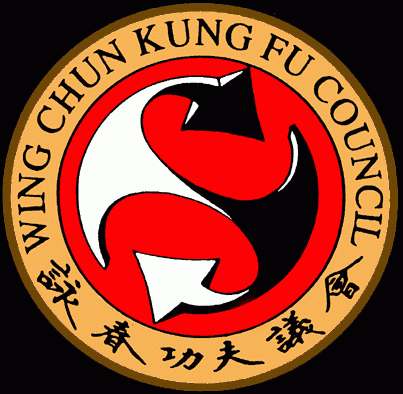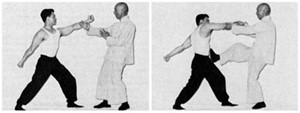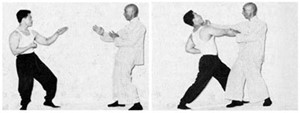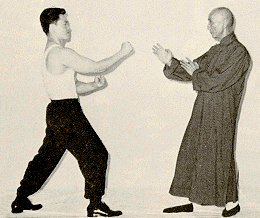RICKY WING CHUN KUEN
Ricky
Wing Chun Kuen (Wing Chun Fist) is a famous Southern style of Chinese Kung Fu. It is said to have been created over 400 years ago by a nun from the Shaolin Temple named, Ng Mui. Her first student was a young girl named, Yim Wing Chun and it is after her that the style takes it name. The story goes that a local bandit was forcing himself on Yim Wing Chun. Seeing what was going on, Ng Mui took pity on the young girl and decided to teach her Kung Fu. After training very hard, Yim Wing Chun challenged the bandit to a fight which she convincingly won.
Grandmaster Ip Ching & Master Ron Heimberger
Though there is a great deal of debate as to the accuracy of this story, what is agreed is that today Wing Chun is one of the most popular and effective forms of Kung Fu. This popularity is due to the teaching of late Great Grandmaster Ip Man who bought the skill from China to Hong Kong and from there it has spread all over the world. Great Grandmaster Ip Man’s most famous student was the legendary Bruce Lee. Since Great Grandmaster Ip Man passed away his legacy to his two sons Grandmaster Ip Chun and Grandmaster Ip Ching. They has taken over their father role. They has spent many years teaching all over the world.
This skill was passed on to Master Ron Heimberger, who is Grandmaster Ip Ching’s most senior student teaching in USA. Master Heimberger in turn passed this skill to his senior student in Massachusetts J. E. Fernandez. Having studied with Master Heimberger for 5 year, Sifu Fernandez has reached a very high standard. He not only enjoys a very close relationship with Master Heimberger, but also with his Sigong (teacher’s teacher), Grandmaster Ip Ching.
What will you learn in Class?
People take up martial arts for many reasons. Some to improve their health & fitness, some to learn how to defend themselves, some for increased sense of confidence and others simply for a pastime to immerse themselves in. The Wing Chun class with its high level of teaching and the friendly relaxed atmosphere caters for all these differing needs.
Chi Sao – Sticking Hands
Chi Sao is the practical training of the applications found in the forms. Whilst training with a partner you will develop sensitivity, footwork and timing. Soon you will begin to understand how to use an opponent’s energy against himself (or herself). Regular practice develops instinctive reactions allowing you to adapt to change without thinking. For successful self-defense this is essential. Chi Sau is like a game and is not meant to be treated as fighting or sparring. It allows you to develop your skill in a safe environment because you can relax and let go.
Wing Chun Forms
Wing Chun has three boxing forms. They represent different stages in training and teach you a great many different elements. The forms are
Sil Lim Tao – Little idea -Reducing Thought
Its main purpose is to train stillness and Gong Lik – internal strength.
Chum Kiu – Looking for the Bridge
Its main purpose is for training our footwork and turning and also the Bong Sau.
Biu Ji – Thrusting Fingers
Its main purpose is the train long distance and short distance attacking techniques using the fingers and elbow.
Wooden Dummy – Mok Yan Jong
The Wooden Dummy training helps us to bring together all we have learnt in Chi Sau and forms to polish our ’fighting techniques’. It also allows us to practice Wing Chun kicks and train the accuracy of our stepping and body position.
Weapons
Wing Chun has two weapons: The Six and a Half Point Pole and the Baat Jam Dao (Wing Chun Knives). The more you train these weapons, the stronger your bones will become and so your Qi will develop to a very high level.
Self Defense
Wing Chun is an extremely practical system. Due to the structure of the training, self-defense ability begins to develop immediately. The more your skill develops the greater your awareness and confidence become, and these are some of the most important resources to have. Then you will be able to see any potential trouble coming before it arrives and can avoid it. However should a situation become unavoidable you will have the physical tools with you when you need them.
Good for Health
Not only is wing Chun a highly effective form of self-defense, it is also a very healthy pastime. It strengthens the body internally as well as externally, and it also helps to relax the mind and the body. Students find the more they train the more at ease with themselves and the world they become. This is one of the most beneficial aspects of good training; it develops you as a person. The best example of this is Great Grandmaster Ip Ching, who is very content with his life, is still healthy, strong and can still easily overcome any students even though he is in his late eighties!
Wing Chun Kuen – or martial arts in general – is about being in control of oneself and therefore the situation (e.g. the attacker), that means a martial art needs to be logical and efficient in order for it to have any practical value. This is guaranteed by the fact that Wing Chun Kuen’s theory is built around essential martial principles and physiokinetics which take human anatomy into account.
Some of the system’s strong points are:
- It can be learnt and used by the average person because the system’s techniques are straightforward
- It does not rely on brute muscular strength
- Attack is the best form of defense
- Pre-emptive striking
- Explosive techniques going in a straight line to the intended target
- Strike the nearest target with the closest available weapon
- Minimum of movement required for maximum effect with the least expenditure of energy to achieve the objective
- In-fighting: close range combat, doesn’t allow the opponent to retaliate because we close in on the adversary
- Once Wing Chun is set in motion, it attacks; or at least simultaneously defends and attacks, but never just goes onto defense alone!
- Launch the attack explosively
- Overwhelm the opponent
The Wing Chun masters of past generations created a quintessential self-defense system, a no-nonsense martial tool, bare of all unnecessary movements and thus providing its adept with an empty-handed weapon.
There are a number of principles and theories which are crucial for a martial art to be most effective in any given circumstance. The founder and subsequent grandmasters of Wing Chun Kuen put these key principles at the very heart of this new system to be. Just to state a select few:
- Economy of motion
- Simultaneous defense and attack
- Using attacker’s own energy to overcome and defeat him
- Not opposing an opponent but blending with his force
Even if some of the Wing Chun principles and theories may seem contradictory at first, in essence they are complementary as can be observed in the following Wing Chun proverbs:
- ‘Circular and straight accompany each other’
- ‘Bent and straight complement one another’
- ‘A hand used for attack serves also to parry’
- ‘Glass-like head, cotton-like belly and iron-like arm bridge’
- ‘Strive to remain calm in the midst of motion’
Next, based on their own extensive martial background they integrated techniques from already existing martial arts which were in accordance with the key principles for unarmed combat (but also applicable against armed combatants) and improved or refined them. Techniques which they found lacking were added and over the span of several generations this new and devastatingly effective martial tool evolved from a set of a few very basic techniques in the beginning into this compact yet complex and sophisticated weapon as we know it today









